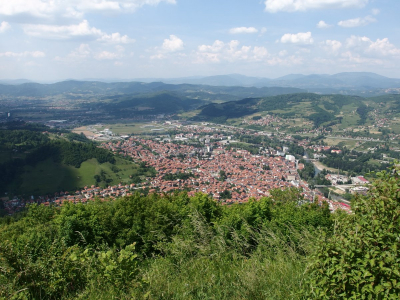The Yugoslav Partisans, or the National Liberation Army, officially the National Liberation Army and Partisan Detachments of Yugoslavia, was the communist-led anti-fascist resistance to the Axis powers (chiefly Germany) in occupied Yugoslavia during World War II. Led by Josip Broz Tito, the Partisans are considered to be Europe's most effective anti-Axis resistance movement during World War II.Primarily a guerilla force at its inception, the Partisans developed into a large fighting force engaging in conventional warfare later in the war, numbering around 650,000 in late 1944 and organized in four field armies and 52 divisions. The main stated objectives of the Partisans were the liberation of Yugoslav lands from occupying forces and the creation of a federal, multi-ethnic socialist state in Yugoslavia.
The Partisans were organized on the initiative of Tito following the Axis invasion of Yugoslavia in April 1941, and began an active guerrilla campaign against occupying forces after Germany invaded the Soviet Union in June. A large-scale uprising was launched in July, later joined by Draa Mihailovi's Chetniks, which led to the creation of the short-lived Republic of Uice. The Axis mounted a series of offensives in response but failed to completely destroy the highly mobile Partisans and their leadership. By late 1943 the Allies had shifted their support from Mihailovi to Tito as the extent of Chetnik collaboration became evident, and the Partisans received official recognition at the Tehran Conference. In Autumn 1944, the Partisans and the Soviet Red Army liberated Belgrade following the Belgrade Offensive. By the end of the war, the Partisans had gained control of the entire country as well as Trieste and Carinthia. After the war, the Partisans were reorganized into the regular armed force of the newly established Federal People's Republic of Yugoslavia.
Visoko (Serbian Cyrillic: Високо, pronounced [ʋǐsɔkɔː]) is a city located in the Zenica-Doboj Canton of the Federation of Bosnia and Herzegovina, an entity of Bosnia and Herzegovina. As of 2013, the municipality had a population of 39,938 inhabitants with 11,205 living in Visoko town. Located between Zenica and Sarajevo, Visoko lies where the river Fojnica joins the Bosna.
The Visoko region has evidence of long continuous occupation, with the first traces of life dating back to the 5th millennium BC. Archaeological excavations of Okolište have found one of the biggest neolithic settlements of the Butmir culture in southeastern Europe.It was an early political and commercial center of the Bosnian medieval state, and the site where the first Bosnian king Tvrtko I was crowned. The Old town Visoki, located on Visočica hill, was a politically important fortress, and its inner bailey Podvisoki was an early example of a Bosnian medieval urban area. After the fall of the Kingdom of Bosnia, medieval Visoko grew as an Ottoman town. A key role in its development was played by the local Bosnian Ajas-pashaOttoman rule ended in 1878 when the Bosnian Vilayet was occupied by Austria-Hungary. On 11 November 1911, in the last years of Austro-Hungarian rule, it was almost completely burned down by an accidental fire. Before the Bosnian War, Visoko was the largest exporter of textile and leather in socialist Yugoslavia As of 2006, Visoko attracts tens of thousands of tourists every year, mainly because of Semir Osmanagić's claims.

1945Apr, 7
World War II: Visoko is liberated by the 7th, 9th, and 17th Krajina brigades from the Tenth division of Yugoslav Partisan forces.
Choose Another Date
Events on 1945
- 23Feb
Manila
World War II: The capital of the Philippines, Manila, is liberated by combined Filipino and American forces. - 23Feb
History of Poland (1939-45)
World War II: Capitulation of German garrison in Poznań. The city is liberated by Soviet and Polish forces. - 25Feb
Turkey
World War II: Turkey declares war on Germany. - 9Mar
Atomic bombings of Hiroshima and Nagasaki
World War II: The first nocturnal incendiary attack on Tokyo inflicts damage comparable to that inflicted on both Hiroshima and Nagasaki five months later. - 30Aug
Douglas MacArthur
The Supreme Commander of the Allied Forces, General Douglas MacArthur lands at Atsugi Air Force Base.

 English
English  español
español  français
français  português
português  русский
русский  العربية
العربية  简体中文
简体中文 